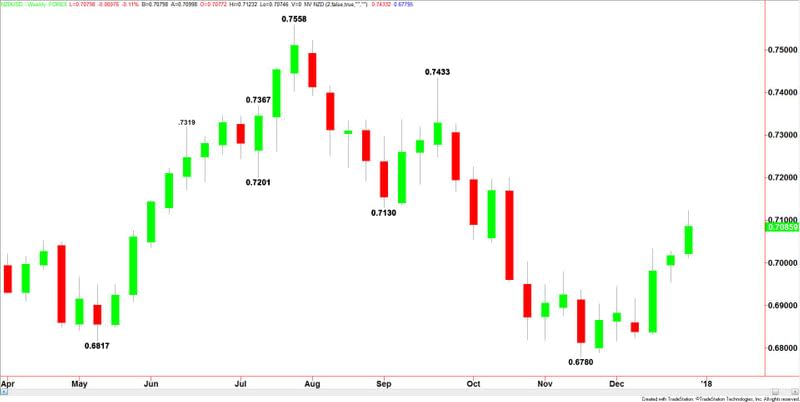AUD/USD and NZD/USD Fundamental Weekly Forecast – May Consolidate Ahead of Fed Minutes, U.S. NFP Report
Rising commodity prices, led by solid gains in iron ore, copper and gold helped underpin the Australian Dollar last week. Demand for these metals must continue to sustain the rally, or investors will start focusing once again on the narrowing spread between Australian Government Bonds and U.S. Government Bonds. The interest rate differential could continue to tighten because the Reserve Bank of Australia is expected to leave interest rates unchanged while the Fed is forecasting at least three rate hikes in 2018.
The AUD/USD settled higher last week, closing at .7803, up 0.0089 or +1.15%

NZD/USD
Higher commodity prices are also helping to underpin the New Zealand Dollar, however, the currency is also getting a boost from optimism over the new government and the new central bank government. The Kiwi has been supported since NZ Superannuation Fund Chief Adrian Orr was named as next governor of the Reserve Bank. Investors feel that installing a seasoned veteran well known by the business community could fuel economic growth.
The NZD/USD closed last week at .7086, up 0.0068 or +0.97%.

The U.S. Dollar dropped all week, culminating with a steep plunge on Friday. The Greenback hit its lowest level in over three months on the last trading day of the year. The annual loss was the largest since 2003. The main catalyst behind the Greenback’s weakness was concern over economic growth in the wake of last week’s biggest tax reform in over three decades.
Falling U.S. Treasury yields have also helped put a lid on demand for the Greenback. This has led to a boost in demand for commodities and commodity-linked currencies.
Forecast
This Aussie and the Kiwi will continue to be driven mostly by the movement in the U.S. Dollar. A weaker dollar will be bullish for commodities and thus, commodity-linked currencies.
If low trading volume was behind last week’s rally then we should expect prices to retreat this week as the major hedge funds and commodity funds return to the markets.
General nervousness and uncertainty over this week’s major U.S. economic reports could also encourage AUD/USD and NZD/USD investors to take profits after last week’s stellar gains.
The Fed is scheduled to release the minutes of its December Federal Open Market Committee meeting on Wednesday. The minutes could move the currencies and the U.S. Dollar because they are expected to reveal more insight into the Fed’s plans to raise interest rates at least three times in 2018. The Australian and New Zealand Dollars could rally if the minutes show that some FOMC members believe there may be only two rate hikes. The Aussie and the Kiwi could weaken if some members show support for three or more rate hikes.
On Wednesday, the ISM Manufacturing PMI report is expected to come in at 58.3, up slightly from the previous 58.2. On Thursday, traders will get the opportunity to react to the latest ADP Non-Farm Employment Change and the Weekly Unemployment Claims reports.
On Friday, the government will release its latest data on employment. Non-Farm Payrolls are expected to show the economy added 189K jobs in December. Average Hourly Earnings are expected to rise by 0.3% and the Unemployment Rate is expected to hold steady at 4.1%. The week ends with the ISM Non-Manufacturing PMI.
This article was originally posted on FX Empire

 Yahoo Finance
Yahoo Finance 